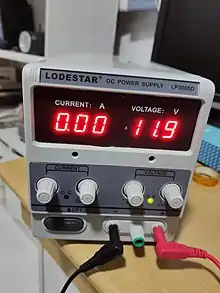Regulated power supply
A regulated power supply is an embedded circuit; it converts unregulated AC (Alternating Current) into a constant DC. With the help of a rectifier it converts AC supply into DC. Its function is to supply a stable voltage (or less often current), to a circuit or device that must be operated within certain power supply limits. The output from the regulated power supply may be alternating or unidirectional, but is nearly always DC (Direct Current).[1] The type of stabilization used may be restricted to ensuring that the output remains within certain limits under various load conditions, or it may also include compensation for variations in its own supply source. The latter is much more common today.
Applications
- D.C. variable bench supply (a bench power supply usually refers to a power supply capable of supplying a variety of output voltages useful for BE (bench testing) electronic circuits, possibly with continuous variation of the output voltage, or just some preset voltages; a laboratory (lab) power supply normally implies an accurate bench power supply, while a balanced or tracking power supply refers to twin supplies for use when a circuit requires both positive and negative supply rails).
- Mobile Phone power adaptors
- Regulated power supplies in appliances
- Various amplifiers and oscillators
Topology & Technology
Many topologies have been used since the regulated supply was invented. Early technologies included iron-hydrogen resistors, resonant transformers, nonlinear resistors, loading resistors, neon stabiliser tubes, vibrating contact regulators etc.
Modern regulated supplies mostly use a transformer, silicon diode bridge rectifier, reservoir capacitor and voltage regulator IC. There are variations on this theme, such as supplies with multiple voltage lines, variable regulators, power control lines, discrete circuits and so on. Switched mode regulator supplies also include an inductor.
At times regulated supplies can be much more complex. An example supply from a 1980s TV which used bidirectional interaction between the main supply and the line output stage to operate, generating a range of output voltages with varying amounts of stabilisation. Since neither stage could start without the other running, the supply also included a kickstart system to pulse the system into operation. The supply also monitored voltages in the TV power circuitry, shutting down if these voltages went out of spec. For special applications, supplies can become even more complex.
